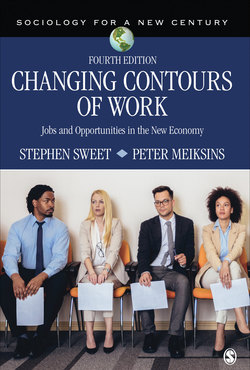Читать книгу Changing Contours of Work - Stephen Sweet - Страница 19
На сайте Литреса книга снята с продажи.
Class Structures
ОглавлениеOne of the great contributions of Karl Marx (1964 [1844]) was his analysis of class structures and how they shaped workplace practices and opportunity structures. In his classic analysis of the industrial capitalist economy, he argued that employers’ profits depend on the effort put forth by employees, which created incentives to limit wages and to push workers to labor as hard as possible. He also observed that the efforts of workers created far greater wealth for employers than it did for employees. Considering these class relations, Marx argued capitalism would tend to organize work in ways that led toward the creation of a polarized class structure, comprising a disenfranchised working class (the proletariat) and an affluent owner class (the bourgeoisie).
It is hard not to look at dead-end low-wage jobs in the new economy without some appreciation for Marx’s core insight. Tammy (the former manufacturing worker) and Mike (the disadvantaged young adult) are what Marx might have expected to see in an advanced capitalist economy. However, the contemporary class structure of the United States is more complex than the bifurcated and polarized structure Marx envisioned, as evidenced by Meg (the trader) and Emily (the contract worker). And the experience of upward movement among the disadvantaged, as evidenced by Rain (the Chinese restaurant worker) and Kavita (the call center worker), adds even more challenges to simplistic Marxist structural models. Although laborers and capitalists exist, large portions of the workforce seem to fit into neither category. Numerous professional and managerial workers have substantial education, some (or even considerable) workplace authority, and higher salaries than the typical frontline worker. Yet it is difficult to describe them as captains of industry or members of the dominant class, given that they are not in charge and work for someone else who has the ability to fire them. Sociologists have argued long and hard about how to describe these intermediate class positions. One sociologist described such workers as occupying contradictory class locations, combining elements of the classes above and below them (Wright 1985).
How best to map the precise shape of the class structure of capitalist societies is a matter for dispute, but what is not disputed is that class matters. For example, class affects people’s access to work opportunities, although the precise way in which it does so has changed over time. Before the Industrial Revolution, most children inherited their line of work from their parents through a process known as ascription. Farmers’ children tended to become farmers themselves, and craft workers would often learn their trade from their fathers. Women’s roles were largely ascribed as well. One’s occupation was to a great extent one of the things inherited from one’s parents; the cross-generational effects of class were obvious and straightforward. With industrialization, however, the range of jobs expanded profoundly, many new occupations were introduced, and other occupations became less common or completely disappeared. As a result of these changing opportunity structures, fewer children could follow in their parents’ footsteps or inherit occupations from the previous generation. By the late nineteenth century, geographic mobility and social mobility became more common, as children ventured farther from their home communities to find work (Thernstrom 1980). Class still mattered, however, because it affected one’s access to resources such as education, skills, and connections that determined access to work in an economy where jobs no longer were inherited.
The existence of class also affects the structure of workplaces. Marx felt that the antagonism between labor and capital inevitably produced antagonism at work and led to the development of hierarchical, top-down managerial structures designed to control workers and ensure that the interests of employers predominated. Although the polarized workplaces envisaged by Marx may not be the dominant organizational form, managerial efforts to control labor reflect a strong desire to respond to class antagonisms. They reflect the reality that the workplace is a zone of contested terrain, one in which class conflicts take place, with each side using the weapons at its disposal—including layoffs, speedups, technology, strikes, and even sabotage (Edwards 1979, Montgomery 1979).
Throughout this book, we argue that social class remains one of the most powerful forces shaping employment opportunities and access to resources in the new economy. We examine how a changing economy has altered the reality of class and the extent to which changes in class structure have led to a fundamental restructuring of workplaces away from the familiar patterns of industrial America. We also examine how gender and race matter and how they interact with class to shape complex, contemporary structures of opportunity and workplaces. We focus on social class most directly in Chapter 3, but throughout we emphasize that other social markers (such as gender, race, or age) intersect with class in important ways.
